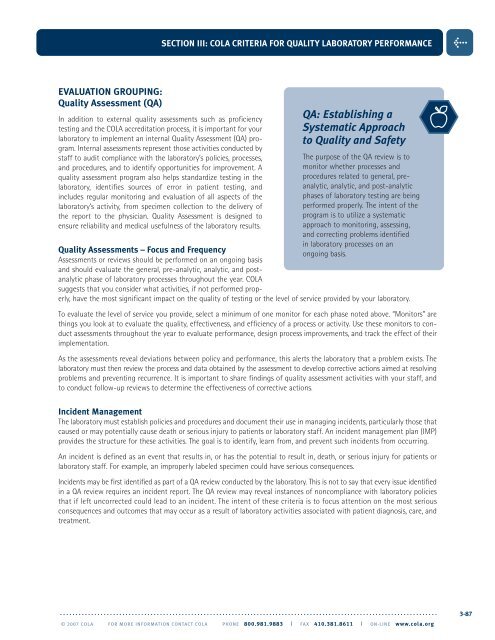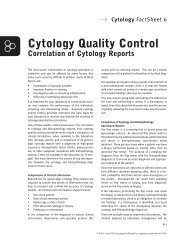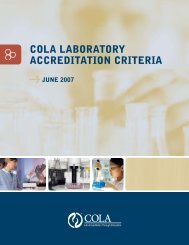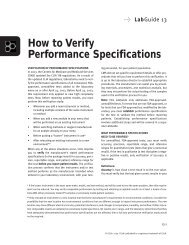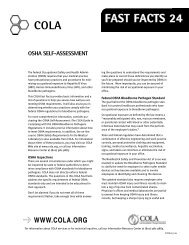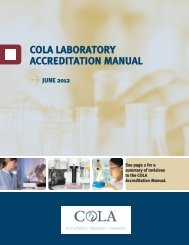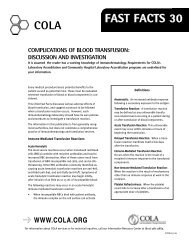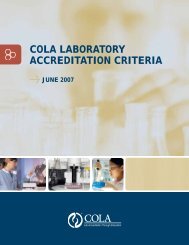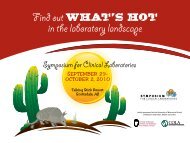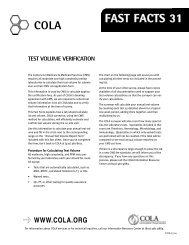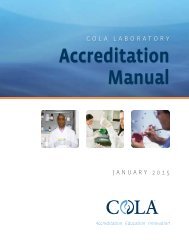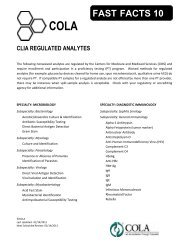Download - COLA
Download - COLA
Download - COLA
- No tags were found...
Create successful ePaper yourself
Turn your PDF publications into a flip-book with our unique Google optimized e-Paper software.
SECTION III: <strong>COLA</strong> CRITERIA FOR QUALITY LABORATORY PERFORMANCE>EVALUATION GROUPING:Quality Assessment (QA)In addition to external quality assessments such as proficiencytesting and the <strong>COLA</strong> accreditation process, it is important for yourlaboratory to implement an internal Quality Assessment (QA) program.Internal assessments represent those activities conducted bystaff to audit compliance with the laboratory’s policies, processes,and procedures, and to identify opportunities for improvement. Aquality assessment program also helps standardize testing in thelaboratory, identifies sources of error in patient testing, andincludes regular monitoring and evaluation of all aspects of thelaboratory’s activity, from specimen collection to the delivery ofthe report to the physician. Quality Assessment is designed toensure reliability and medical usefulness of the laboratory results.QA: Establishing aSystematic Approachto Quality and SafetyThe purpose of the QA review is tomonitor whether processes andprocedures related to general, preanalytic,analytic, and post-analyticphases of laboratory testing are beingperformed properly. The intent of theprogram is to utilize a systematicapproach to monitoring, assessing,and correcting problems identifiedin laboratory processes on anongoing basis.Quality Assessments – Focus and FrequencyAssessments or reviews should be performed on an ongoing basisand should evaluate the general, pre-analytic, analytic, and postanalyticphase of laboratory processes throughout the year. <strong>COLA</strong>suggests that you consider what activities, if not performed properly,have the most significant impact on the quality of testing or the level of service provided by your laboratory.To evaluate the level of service you provide, select a minimum of one monitor for each phase noted above. “Monitors” arethings you look at to evaluate the quality, effectiveness, and efficiency of a process or activity. Use these monitors to conductassessments throughout the year to evaluate performance, design process improvements, and track the effect of theirimplementation.As the assessments reveal deviations between policy and performance, this alerts the laboratory that a problem exists. Thelaboratory must then review the process and data obtained by the assessment to develop corrective actions aimed at resolvingproblems and preventing recurrence. It is important to share findings of quality assessment activities with your staff, andto conduct follow-up reviews to determine the effectiveness of corrective actions.Incident ManagementThe laboratory must establish policies and procedures and document their use in managing incidents, particularly those thatcaused or may potentially cause death or serious injury to patients or laboratory staff. An incident management plan (IMP)provides the structure for these activities. The goal is to identify, learn from, and prevent such incidents from occurring.An incident is defined as an event that results in, or has the potential to result in, death, or serious injury for patients orlaboratory staff. For example, an improperly labeled specimen could have serious consequences.Incidents may be first identified as part of a QA review conducted by the laboratory. This is not to say that every issue identifiedin a QA review requires an incident report. The QA review may reveal instances of noncompliance with laboratory policiesthat if left uncorrected could lead to an incident. The intent of these criteria is to focus attention on the most seriousconsequences and outcomes that may occur as a result of laboratory activities associated with patient diagnosis, care, andtreatment.. . . . . . . . . . . . . . . . . . . . . . . . . . . . . . . . . . . . . . . . . . . . . . . . . . . . . . . . . . . . . . . . . . . . . . . . . . . . . . . . . . . . . . . . . . . . . . . . . . . . . . . . . . . . . . . . . . . . . . . . .© 2007 <strong>COLA</strong> FOR MORE INFORMATION CONTACT <strong>COLA</strong> PHONE 800.981.9883 | FAX 410.381.8611 | ON-LINE www.cola.org3-87


